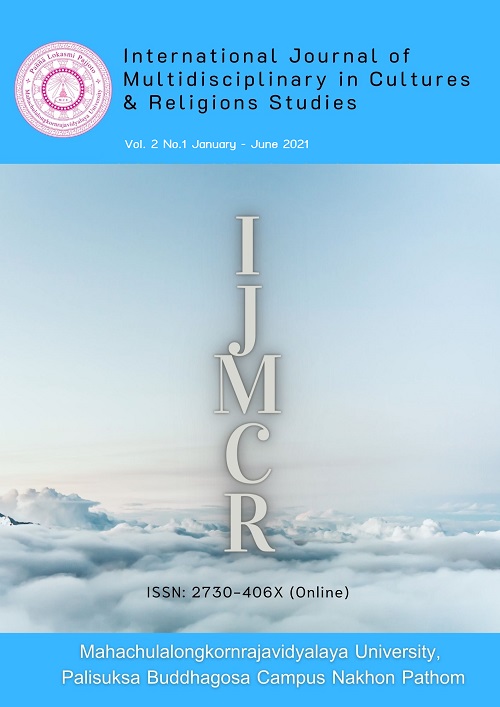The Vinaya (Discipline) As the Core of Buddhism for Response to the Social Conflict
Main Article Content
Abstract
The present world is obviously made up of complex societies, which have undergone tremendous changes through the ages and this change will continue. The world is shrinking day by day at a faster pace than ever before. Countries do easily get connected through various modes of transport and communication and people get to know any event happening in any corner of the world any time. These changes are not without its problems. Societies have reached an anomic stage that situation has arisen where the norms of society are unclear and no longer applicable to the current conditions leading to an increase in the rate of social conflicts such as Terrorism, Murder, Prostitute, Rape, Corruption, Anti-race, Anti-Religion, Drug, Alcoholism etc. On this connection, in the recent conditions, there are the religious institutions have a lot of effort to manage different aspects of social problem. All emphatic religions are tried to find an answer, for to find out which of these issues. So, when a social conflict has been occurred, the society of human being needs to have regulation for controlling and preserving harmony, which is nothing other than jurisprudence.
Article Details
References
Bodhipala, B. et.al. (eds.) (2009). Jagajjyoti (1908-2008): Centenary Volume. Kolkata: Buddha Dharmankur Sabha.
Dannal K. Swearer (ed.) (1991). Me and Mind: Selected Essays of Bhikkhu Buddhadasa. Delhi: Sri Satguru Publication.
Dutt, S. (2000). Buddhist Monks and Monasteries of India: Their History and Their Contribution to Indian Culture. Delhi: Motilal Banarasidass Publishers.
Geiger, W. (1996). Pli Literature and Language. New Delhi: Munshriram Manoharlal Publishers.
Gokuldas, D. (1955). Democracy in Early Buddhist Sagha. Calcutta: Calcutta University.
Harvey, P. (2005). An Introduction to Buddhism: Teaching, History and Practices. New Delhi: Cambridge University Press.
Hazra, K. L. (1998). Pali Language and Literature: A Systematic Survey and Historical Study. New Delhi: D.K. Prinworld.
His Royal Highness Prince Kitiyrakara Krommaphra Chandaburinarunath (1994).. Pli – Thai – English – Sanskrit Dictionary, Reprinted. Bangkok: MBU Press.
Holt, J. C. (2015). The Canonical Buddhism of the Vinayapiaka. (2nd ed.). Delhi: Motilal Banarsidass.
Horner, I. B. (1992). The Book of the Discipline, Vol. I. Oxford: The Pli Text Society.
Jayatilleke, K. N. (1967). The Principle of International Law in Buddhist Doctrine. Sri Lanka: Martinus Nijhoff Publicers.
Jayawickrama, N. A. (2010). Inception of Discipline and Vinaya-Nidna. U.K.: The Pli Text Society.
Kalupahana, D. J. (2008). Ethics in Early Buddhism. Delhi: Motilal Banarsidass.
Kalupahana, D. J. (2008). Ethics in Early Buddhism. Delhi: Motilal Banarsidass.
Keown, D. (2003). Dictionary of Buddhism. USA: Oxford University Press.
Khantiplo, B. (2008). The Buddhist Monk’s Discipline: Some Points Explained for Laypeople, Sri Lanka: Buddhist Publication Society.
Mahipal, S. (2001). A Comparative Study of The Rule of Law in Buddhist Vinaya and Indian Legal System (Doctoral dissertation). University of Delhi.
Mishra, G. S. P. (1972). The Age of Vinaya: A Historical and Cultural Study. New Delhi: Munshiram Manoharlal.
P.A. Payutto. (2002). The Pli Canon: What the Buddhist Must Know. Thailand: Wat Nyanavesakavan.
Pandey, S. K. (2002). Abhidhamma Philosophy. Delhi: Indo-Asian Publication House.
Payutto, P. A. (2010). Dhamma Bilingualized. (translated by Chanawangsa, S.). Bangkok: Chareanmonkong Press.
Payutto, P.A. (2008). Dictionary of Buddhism. (11th ed.). Bangkok: S. R. Printing Mass Product.
Payutto, P.A. (2008). Vision of the Dhamma: A Collection of Buddhist Writings in English. Thailand: Wat Nyanavesakavan.
Sarao, K.T.S. (1990). The Origin and Nature of Ancient Indian Buddhism. Delhi: Eastern Linkers.
Singh, R. N. (2007). Buddhism: From Genesis to Decline. Delhi: New Bharatiya Book Corporation.
The Pali Text Society. (n.d.) Tipitaka PTS (Pali Canon in Pali text) 55 Books. London: The Pali Text Society.


